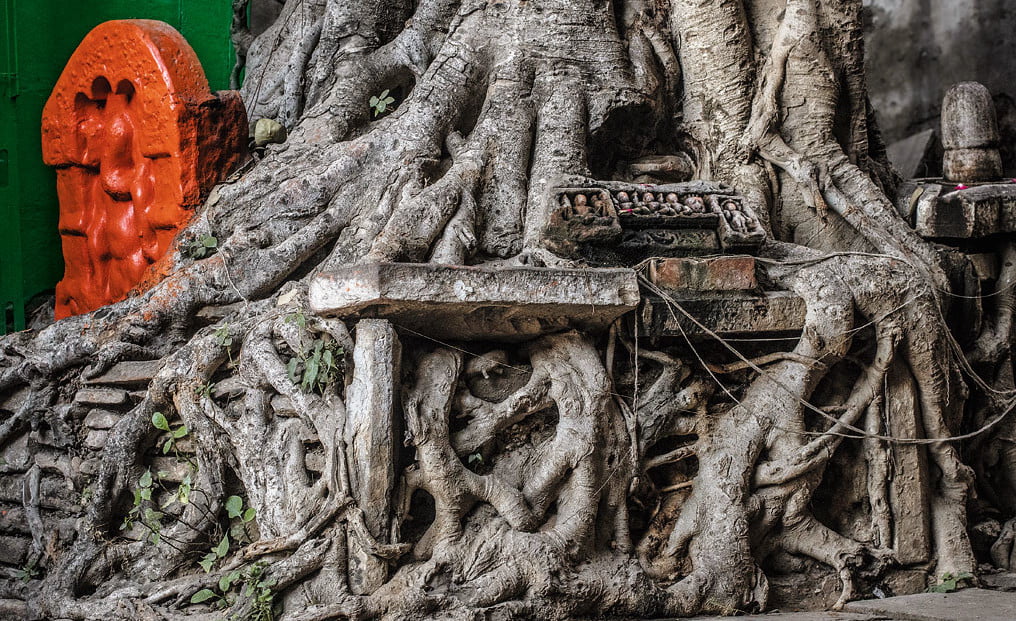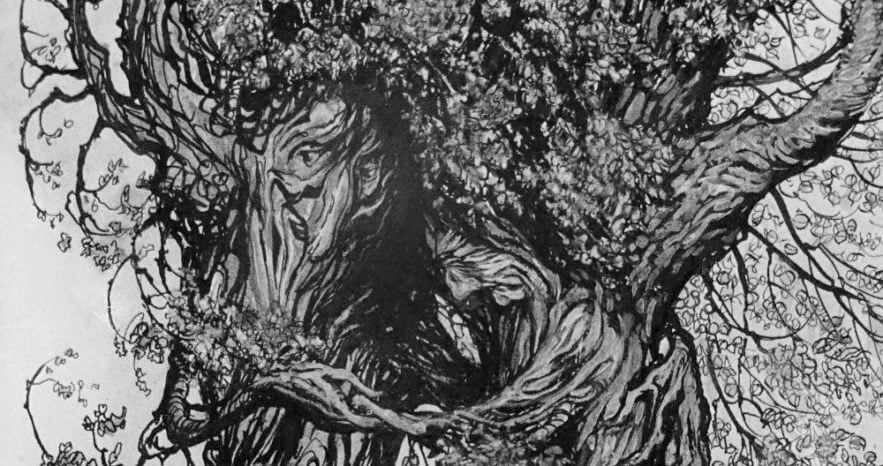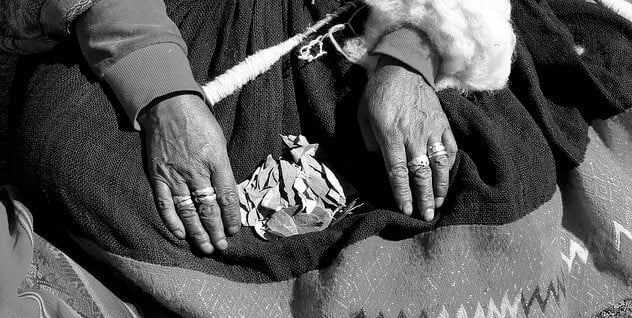Discover legends, myths and folklore of the Banyan tree in India and its ritual use in Desi culture. As Kalpavriksha or Banyan tree is sacred in Hindu and Jain cosmology and Buddhism, known as the Tree of Life or World Tree.
In this Article
Ficus Benghalensis

Sanskrit: Nyagrodha, Kalpavriksha, Vat-vriksha, Bahupada,
Hindi: Vata, vad, Bargad, Ber
English: Banyan Tree or Sacred Fig
The Banyan tree is one of the most venerated trees in India. It has the ability to survive and grow for years and is often compared to the shelter given by God to his devotees.
Indians knew the Banyan tree as the Vatvriksha. When the British came to Bharat, the story goes, they noticed that members of the trading community or Bania used to gather under a large shady fig tree, and named it Banyan.
Other names are: Ficus banyana, Indian Banyan, East Indian Fig Tree, Ara Banyan and Bayan.
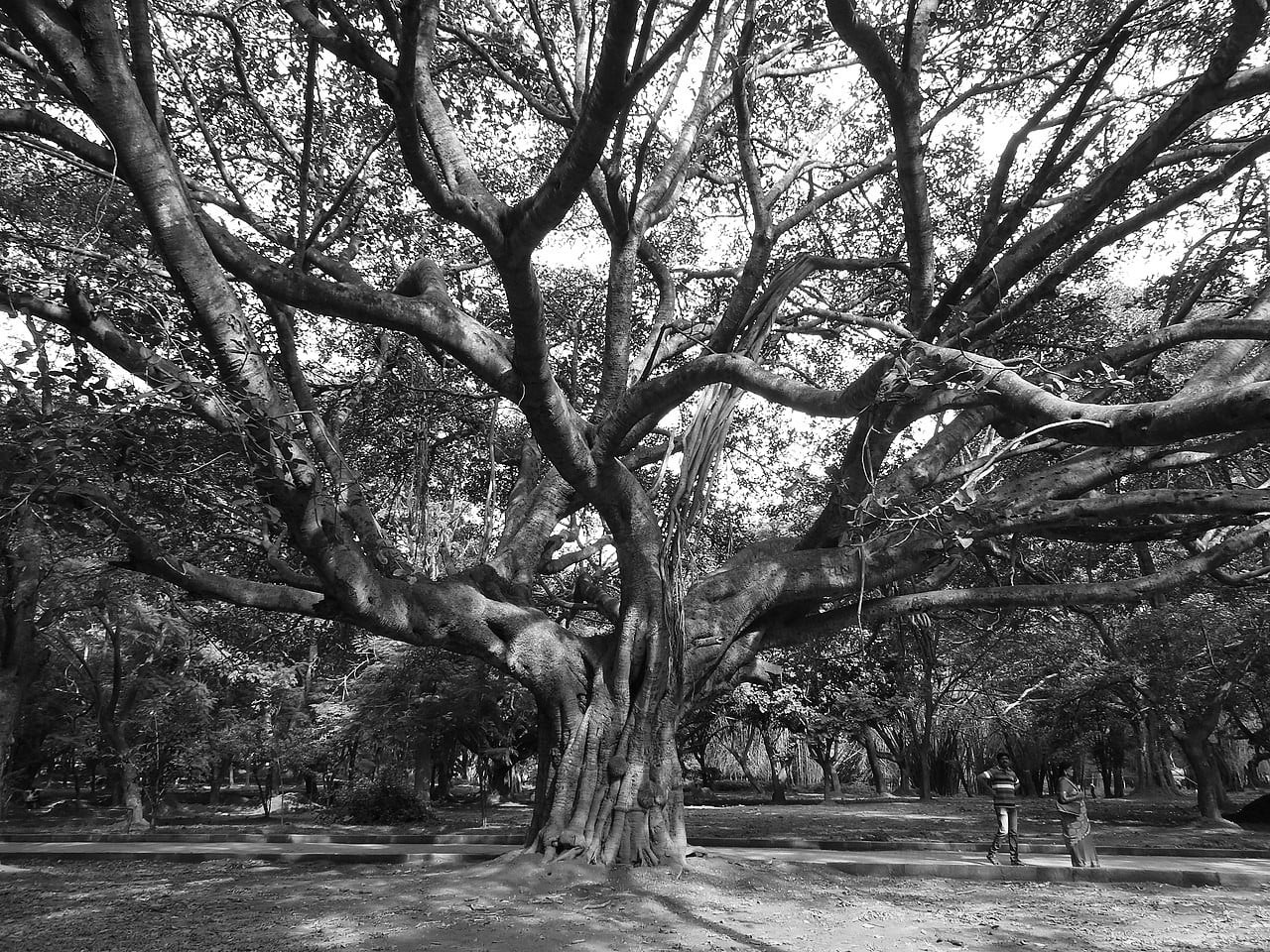
Kalpavriksha कल्पवृक्ष
In Hindu mythology, the tree is called Kalpavriksha, the tree that provides fulfillment of wishes and other material gains.
The birth of the kalpavriksha happened during the samudra manthan or churning of the ocean as per Hindu mythology.

Along with Kalpavriksha, the wish fulfilling tree, the wish fulfilling cow kamadhenu was also born. Lord Indra is supposed to have taken them to heaven, devaloka, along with him and planted it there.
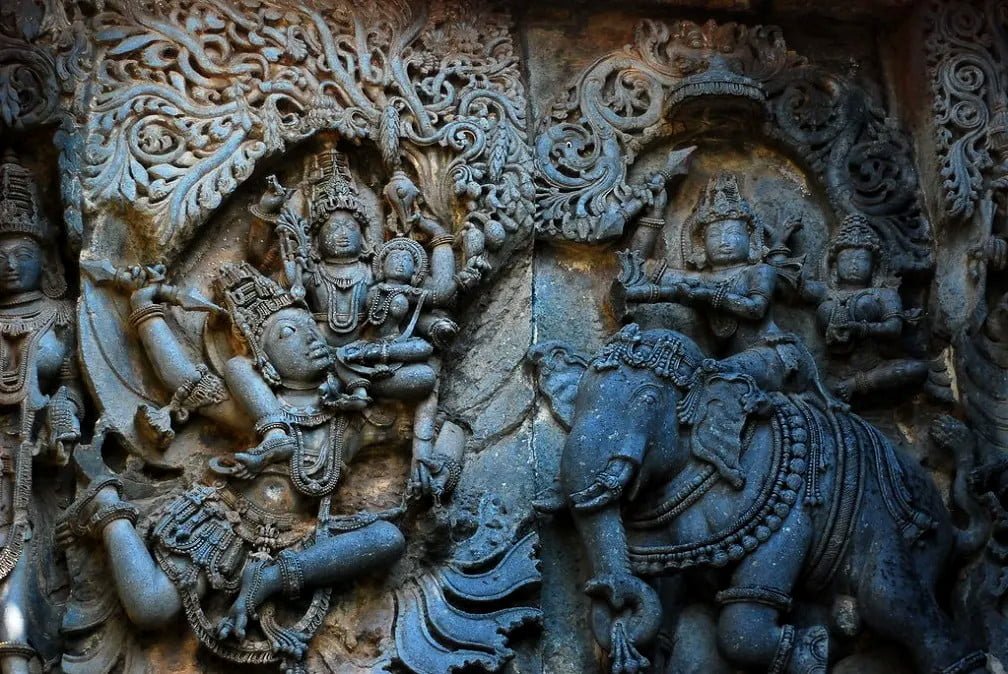
As per mythology there are several kalpavrikshas; mandana, parijata, santana, kalpavrikhsa and harichandana. All these are believed to grant different wishes to the devas or gods and out of jealousy the asuras or demons waged wars with them.
The Shaiva myth of Aranyani ties very closely to Kalpavrisksha
One day, goddess Parvati was standing with her husband Shiva at the foot of a Kalpavriksha tree. Parvati was enraptured with the beauty of the tree and wanted to know why this one was more special than the others. Shiva told her to offer a wish to the tree.
Parvati meditated for a few moments before praying, “Oh Divine Mother! You, who is present everywhere, you who is the embodiment of power and Energy! Please bless us with a most beautiful girl with nine divine gifts of peace, purity, knowledge, energy, patience, respect, prosperity, success and happiness.” With a touch of breath from Shiva, Parvati’s wish was at once fulfilled as the most beautiful young girl emerged from the Kalpavriksha tree. Parvati named her Aranyani.
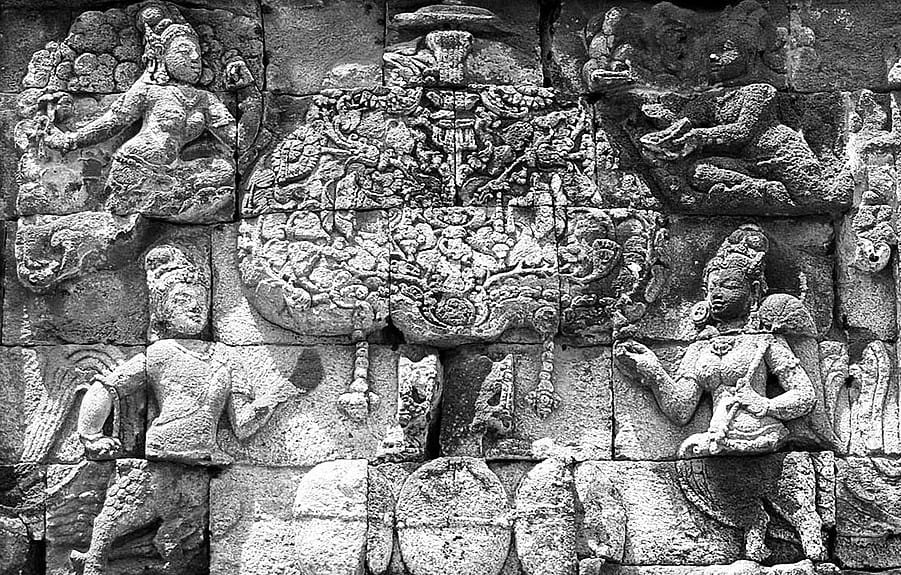
According to the epics, kalpavriksha or kalpadruma was gifted to Aranyani. The chief aim was to protect the tree, so we often see it being guarded by kinnaras, apsaras, and animals, such as lions, peacocks, etc.
Another daughter Ashokasundari was created from a Kalpavriksha to be a companion to Parvati during a period of loneliness.
Aranya means “forest” in Sanskrit. While most people fear wild places, goddess Aranyani is fearless, dwelling in the jungle amongst the fiercest of beasts and the most dangerous of terrains.
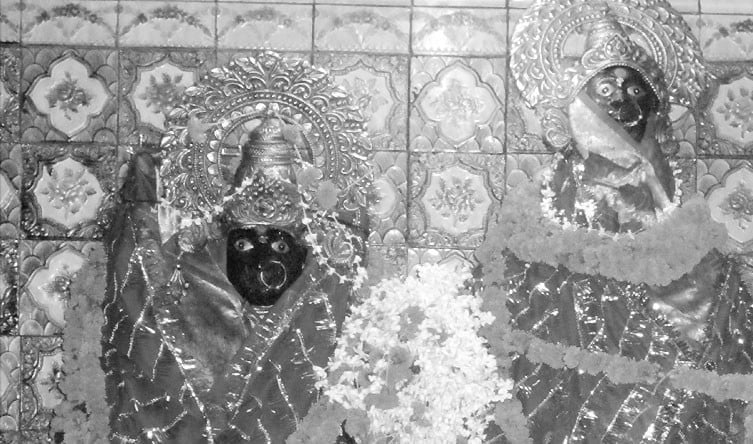
In Arrah, a city in the Bhojpur district in the state of Bihar, India, there is a temple known as the Aranya Devi Temple which is dedicated to the goddess. Aranyani is a goddess of the forests and all the animals within them.
Worshipped in Bharat as the chief expression of life and fertility, one of the most descriptive hymns in the Rigveda was dedicated to Aranyani.
In the hymn, the supplicant entreats her to explain how Aranyani can wander so far from civilization without becoming afraid or lonely. Aranyani seems to be a peaceful and happy goddess who loves to dance. Although she is seldom seen, she wears anklets with bells, and her steps can be heard by the tinkling of her anklets.
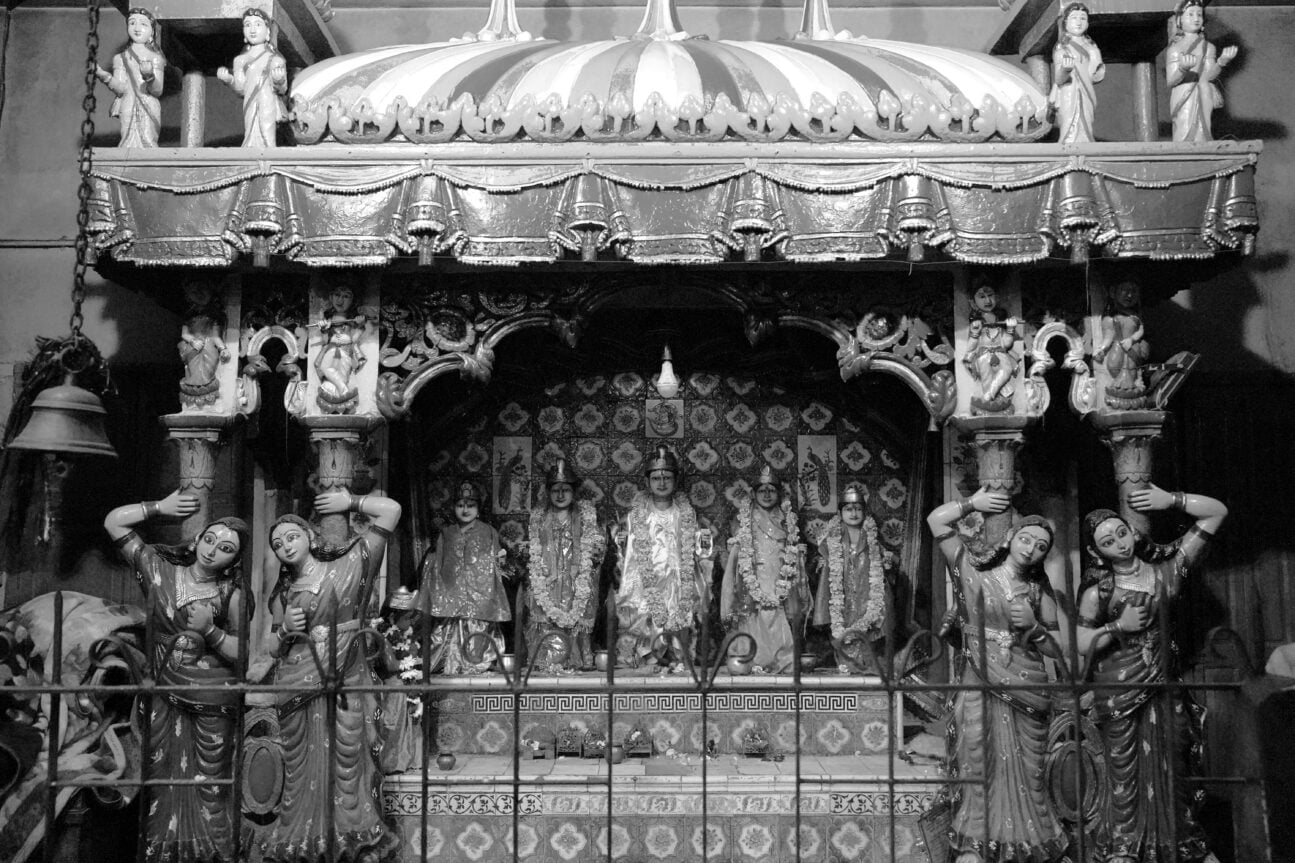
There are many legends regarding the temple:
Krishna and The legend Of Aranya Devi Temple
Once Lord Krishna disguised as a hermit and Arjun as a lion went to King Mordhwaj at Arrah, who was renowned for his generosity. The hermit demanded human flesh for his lion saying that the lion did not eat animal flesh. The hermit (Lord Krishna) asked for the flesh of the kings son. The king was puzzled and asked for the consent of his wife. His wife agreed. The hermit asked them to dissect the body of the boy with an arra (saw).
This was done jointly by the king and the queen. The hermit demanded that the flesh be cooked by them. The king and the queen obeyed him at once. Now they were asked to eat the cooked flesh together with the hermit and the lion. This was also obeyed. The hermit asked the king to call the boy and partake of the meal. The king said that the boy was killed and cooked.
The hermit said, “No, call the boys.” The king called out the name of the boy. To their sheer amazement and joy, the boy appeared before them in a playful manner. Then Lord Krishna and Arjun gave revealed their identity and threw away the arra (saw) which was used in dissecting the body of the boy. The temple is said to have been erected by King Mordhwaj at the place where the saw fell.
Ganga and The legend Of Aranya Devi Temple
The area was covered with forest and Ganga river was flowing near by and the people built a temple there which was called the temple of Aranya Devi, i.e., goddess of the forest.
King Mordhwaj and The legend Of Aranya Devi Temple
King Mordhwaj was also a great benefactor and charitable-minded. He was a very kind-hearted man noble, gentle, loving, faithful, honest and simple. His name and fame spread all over India. The fort of King Mordhwaj was a very big and spacious one covering the present Chowdhariana Mohalla, Jain School area and Devi Asthan sector.
But in spite of so much prosperity and gaiety, the king and the queen were not happy at all because they had no son. And so with intense devotion they began praying to the goddess Durga to bless them with a son. Finally the divine blessing did dawn upon them. The goddess appeared before the king in his dream and gave her blessing, and nine months after a son was born.
The royal boy was a prodigy and provided all the earthly pleasures to his parents. And so the years rolled away. One night King Mordhwaj was in his dream goddess Durga asking him to sacrifice his son before her altar.
In the dream the divine mandate was that the imperial boy should be made to stand before the altar and the king and the queen, standing on either side of him, were to ply the saw from the boys head downwards till his body was cut into two halves, with the blood falling before the altar and with no tears trickling down their eyes.
The king took the dream seriously, conveyed it to his royal consort and both agreed to execute the mandate. And the royal prince also did not demur and was happy about the fulfilment of the divine wish.
So the trial came. The king and queen applied the saw (arra) on the head of the prince and, just as they were starting to ply the saw, the divine mother appeared physically before the scene of sacrifice, blessed the couple and the prince for their devotion to her and disappeared in the blue.
It was in this way that the place which was the scene of the sacrifice came to be known as ARRAH, meaning a saw. It is also believed that the king installed a temple at Arrah which was called Aranya Devi temple.
Kalpavriksha

Worship of the Nyagrodha or Kalpavriksha tree as a form of non-human worship is depicted in a Buddhist sculpture at Besnagar, Madhya Pradesh. The sculpture, also known as Vidisa (Bhilsa), is dated to third century BC.
The sculpture, possibly the capital of a pillar, represents a banyan tree, enclosed by a railing at the base and higher up by a bamboo fence in the shape of a network. The branches of the tree bear coin purse, a conch shell, a lotus and a vase overflowing with coins.
Ancient texts, such as the Ramayana and Mahabharata, frequently mention a term, Chaitya-vriksha. Interestingly both chaitya-vriksha and kalpavriksha are similar in concept. Chaitya-vrikshas are tree shrines with dense leaves and fruits that provide shelter and food for all living beings.
These are open air shrines with railing or fence like structures that cover the tree trunks, or sometimes the tree is placed on a pedestal. Various tree spirits known as yakshas and yakshis, and Apsaras, female spirits living in trees. Sometimes even the nagas, snakegods, are believed to live in these trees.
The trees are worshipped as protectors of both human beings and gods alike. It is interesting how women and men acknowledged the importance of trees in our lives and venerated them in various ways.
In India, the sacred kalpavriksha refers to both the ficus varieties (religiosa and bengalensis), that is, both the Pipal and Banyan.
Kalpavriksha is also identified with many other trees such as:
- Parijata – Erythrina variegata,
- Coconut palm – Cocos nucifera,
- Mahua or Mowra Butter Tree – Madhuca longifolia,
- Mimosa cineraria – Prosopis cineraria,
- Indian butter tree – Bassia or Diploknema butyracea,
- Banana – Musa, not a tree, but a berry and
- Mulberry tree – Morus nigra tree.
All these trees are known to have medicinal properties, besides other uses in daily lives. All parts of the Sacred Fig have been used as a medicine for their cooling and healing properties, as part of the Ayurvedic healing system.
The Jain Kalpavriksha
In Jain cosmology, there are 10 Kalpavrikshas which grant 10 distinct wishes. It is said that in the three aras (periods) of humanity, Kalpavrikshas provided all that was needed, but towards the end of the third ara, the yield from them diminished.
We were standing under this fine carving of the wish fulfilling tree at the entrance of the Jain temple at Ranakpur, near Udaipur Rajasthan. Of course, we would wish for …

Brahama
The Banyan tree is mentioned in many scriptures as a Tree of Immortality, Tree of life or World Tree. Its aerial roots grow down into the soil forming additional trunks and called Bahupada बहुपाद, the one with several feet.
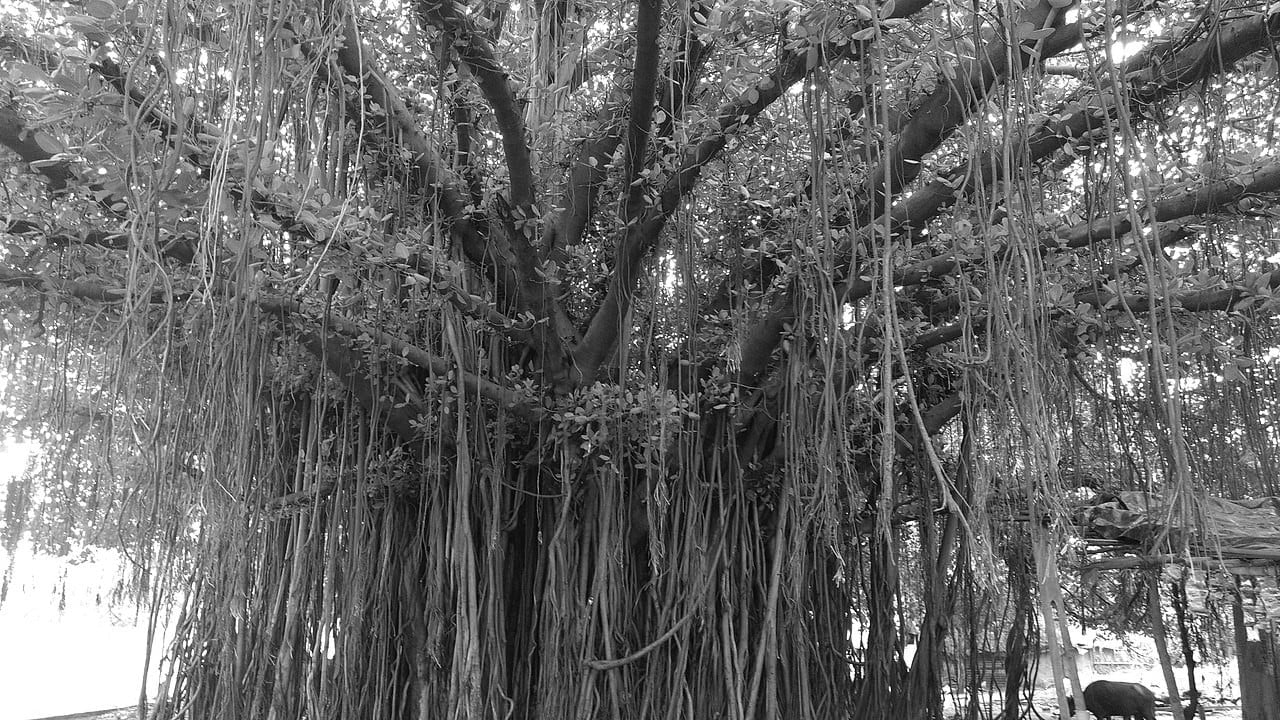
It symbolizes longevity and represents the divine creator, Brahma. The rustling of the leaves of the tree is attributed to the deities residing on it. It grows on Pushkara dvipa, a special abode of Brahma.
Vishnu
In Vishnu Parana, the tree is compared to Vishnu.
“As the wide spreading Nyagrodha tree is compressed in a small seed, so at the time of dissolution, the whole universe is comprehended in thee as its germ.
As the Nyagrodha germinates from the seed and becomes first a shoot and then rises into loftiness, so the created world proceeds from thee and expands into magnitude”.
Nyagrodha planted in front of temples is tenanted by either Krishna or Shiva.
The tree planted in public places like cross-roads, village squares are tenanted by lesser divinities such as Yakshas, Kinnaras, Gandharvas etc.
Krishna, as Vatapatrasayi, the Lord on the Banyan Tree leaf
In Sanskrit, this particular form of Krishna is called Vatapatrasayi, Lord of the Banyan Leaf. The imagery of a baby Krishna reclining on a banyan tree (vatavriksha) or leaf (vatapatra) is beautifully rendered in both Indian paintings and sculptures.
A plethora of myths and stories from Krishna’s infancy and childhood revolve around him as the ultimate savior of the universe.

While there are different versions of the pralaya myth in scriptures like the Mahabharata, the Matsya Purana and the Bhagavat Purana, the idea is similar.
According to the twelfth book of the Bhagavata Purana, the sage Markandeya gained immortality and swam across the cosmic ocean indefinitely, witnessing the horror of the great deluge, as humanity disappears under water.
Suddenly he spots a little child floating on a banyan leaf on the dangerous torrents, grabbing his lotus-like toe and placing it in his mouth.
Infant Krishna, opened his mouth to reveal the creation of the universe. The great sage then realizes that the baby is a god, who has withdrawn the world into himself before recreating the universe. Krishna’s infancy represents the formation of a new world cycle.
Yama
The Banyan is associated with Yama, the god of death and the tree is often planted near crematoria. The Banyan does not let a blade of grass grow under it. Thus, it does not stand for rebirth and renewal. That is why it is not part of fertility ceremonies like marriage and childbirth.
There are tree shrines as idols consecrated below the Banyan, and even today women go around these trees longing for eternity of their marriages in the memory of Savitri who lost Satyavan under a Banyan and later regained his soul from Yama.
Savitri and Satyavan.
It has been foretold that Satyavan won’t live long. Resting on the lap of Savitri, Satyavan was waiting for death under a banyan tree, when the day of death came. The messenger of Yama, the God of death came to take Satyavan. But Savitri refused to give her beloved husband. Messenger after messenger tried to take Satyavan away, but in vain. Finally, Yama himself appeared in front of Savitri and insisted to give over her husband. Since, she was still reluctant, he offered her a boon.
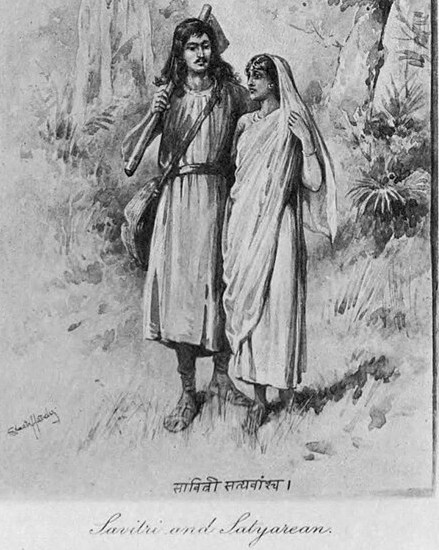
She asked for the well-being of her extended family. He granted it to her. She then followed him as he took Satyavan’s body away. He offered her another boon. She again asked for the well being of her parents. This boon, too, was granted. But she was relentless, and continued to follow him. As they approached Yama’s abode, he offered her a final boon.
She asked for a son. He granted it. She then asked him how it would be possible for her to beget sons without her husband. Yama was trapped and had to return her husband.
Married woman pray to a banyan tree for their husbands
Following the legend married women pray to the banyan tree for the long life of their husbands and children. A fast is observed the whole night till the next morning.
There are several celebrations derived from the legend across India.
In western Bharat, Purnima (full moon) of the month as Vat Purnima, a festival of women is celebrated.
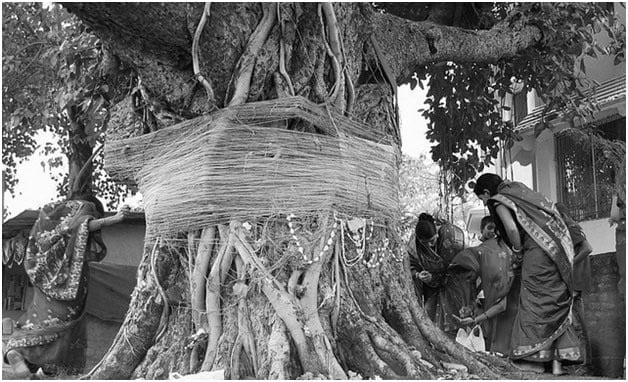
On this day called Vata Savitri Poornima, women pray for long life of their husbands and children. Women observe a fast and tie threads around a banyan tree and pray for the same husband in every birth. Many women are named “Savitri”.
Married women in Bihar, Jharkhand, and Odisha,observe Savitri Vrata on the Amavasya (new moon) day in the month of Jyestha every year. A book entitled Savitri Brata Katha in the Odia language is read out by women while performing the puja, celebration. The wives pray for the well-being and long life of their husbands.
In South India, it is believed that Savitri got her husband back on the first day of the Tamil month Panguni. This day is celebrated as Karadayan Nonbu in Tamil Nadu. Married women and young girls from the age of one onwards, wear yellow robes. Wives pray to Hindu goddesses for long lives for their husbands and unmarried girls to find a good husband in future.
Shiva
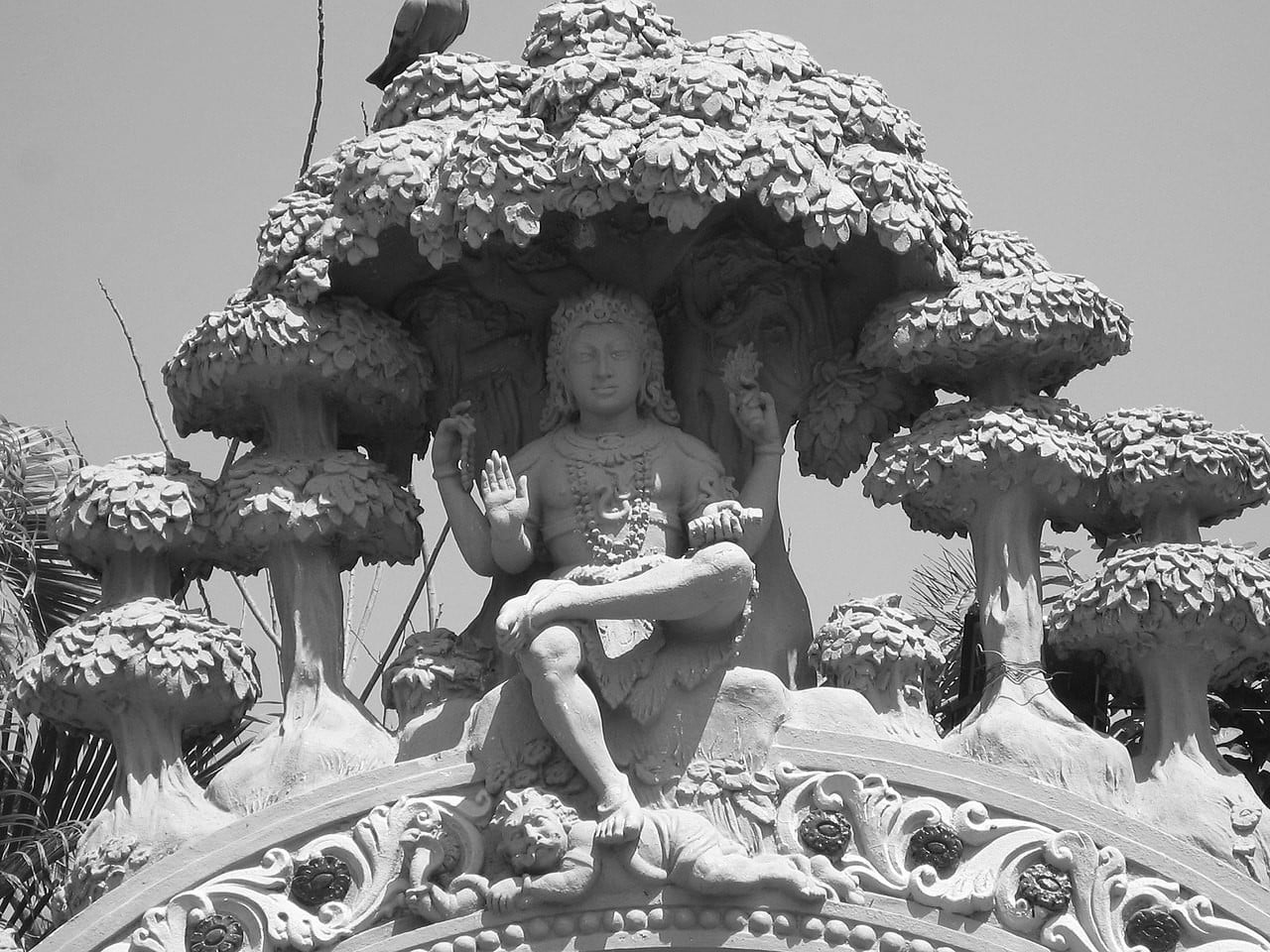
Yoga Dakshinamurti is an aspect of Shiva as a guru (teacher) of yoga, music, and wisdom:
In iconography, Lord Shiva is visualized as Dakshinamurti (Giver of true knowledge), he who faces the south, that being the direction of death and change.
He is shown sitting under a banyan tree. His one leg rests on the ground, crushing ignorance – as represented by the mythical apasmara under the feet of the deity. The foot lies folded on his lap. His four arms are shown in different ways.
He carries a rosary or mala in his upper right hand; the upper left hand is shown as carrying fire; the lower right hand is depicted in abhayamudra – ; and the lower left hand is holding the Shastras. A genre of Sanskrit texts on law and conduct or treatises, called śāstras on Dharma.
Below his seat an apasmara (demon) is crushed under the feet and a cobra is around his arm and looks towards him.
The Abhaya Mudra, a gesture with the hand lifted above thigh with palm facing out, fingers pointing, is interpreted as his grace upon his students.
The rosary or the snake signifies tantric knowledge. The fire represents illumination, removing the darkness of ignorance. He sits under the Banyan tree, the botanical embodiment of the universe, facing the terror of death and change,– stoically, unafraid – because of his profound understanding of the world.

Dakshinamurti (Shiva) under a Banyan Tree with his students (Kumaras)
According to another school of thought Dakshinya means Karuna in Sanskrit or kindness (benevolence). So, this manifestation of Shiva is a benevolent teacher who accords wisdom to seekers of salvation.
At the Tiruvannamalai Temple, Tamil Nadu, India, four sages, sit around Shiva and under the Banyan, they are :
- Sanatkumara (always a youth),
- Sanaka (ancient),
- Sanatana (eternal),
- Sanandana (having joy).
They are born from the mind of Brahma and live eternally as Brahmacaris, Kumaras, students or disciples.
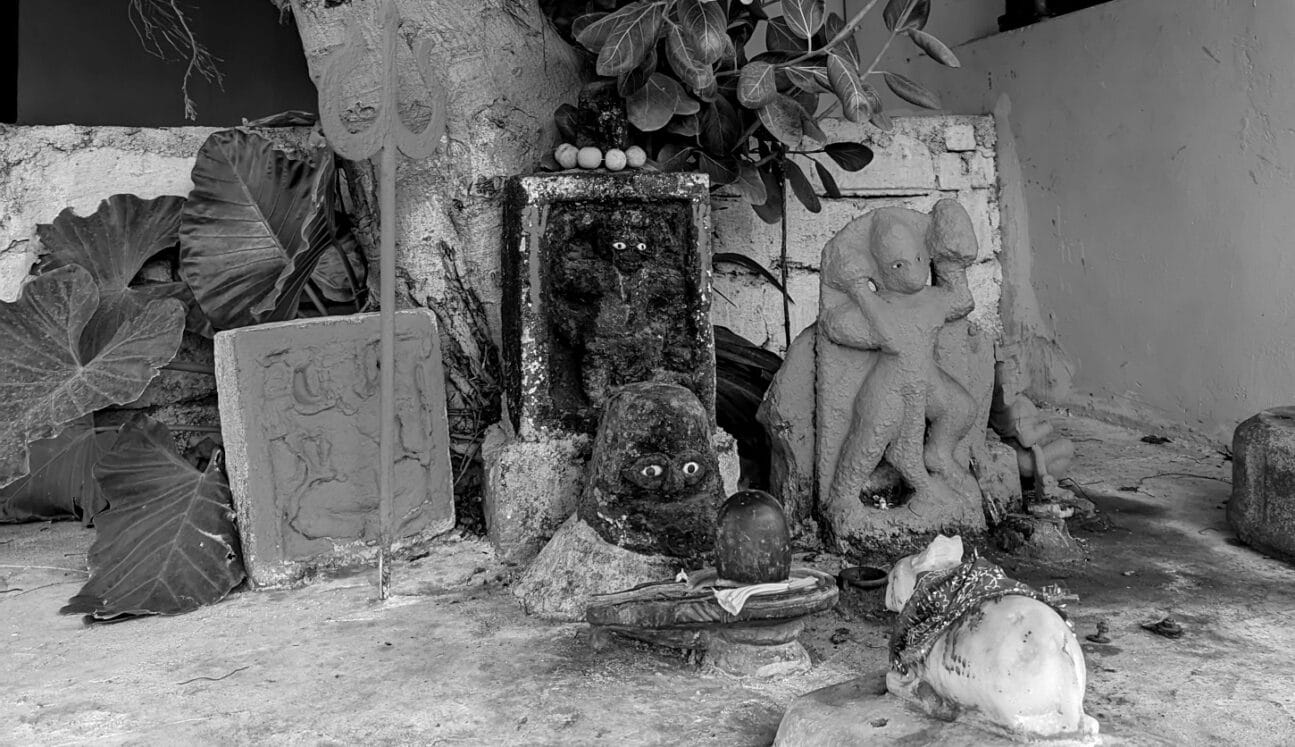
The Taboo of the Oriyan tribes
To some Oriyan tribes, the tree is the Sadru-shrine of the gods and it is a sacrilege to cut it. The taboo against felling it is so great that if anyone cuts it in ignorance, he has to sacrifice a goat to the gods living on the tree.
Some Indians consider the tree as a mother, for according to a legend, two orphan children were left under the tree and they were nourished by the milk or the latex that dripped from it and were thus saved from starvation.
Bodhi tree in Buddhism
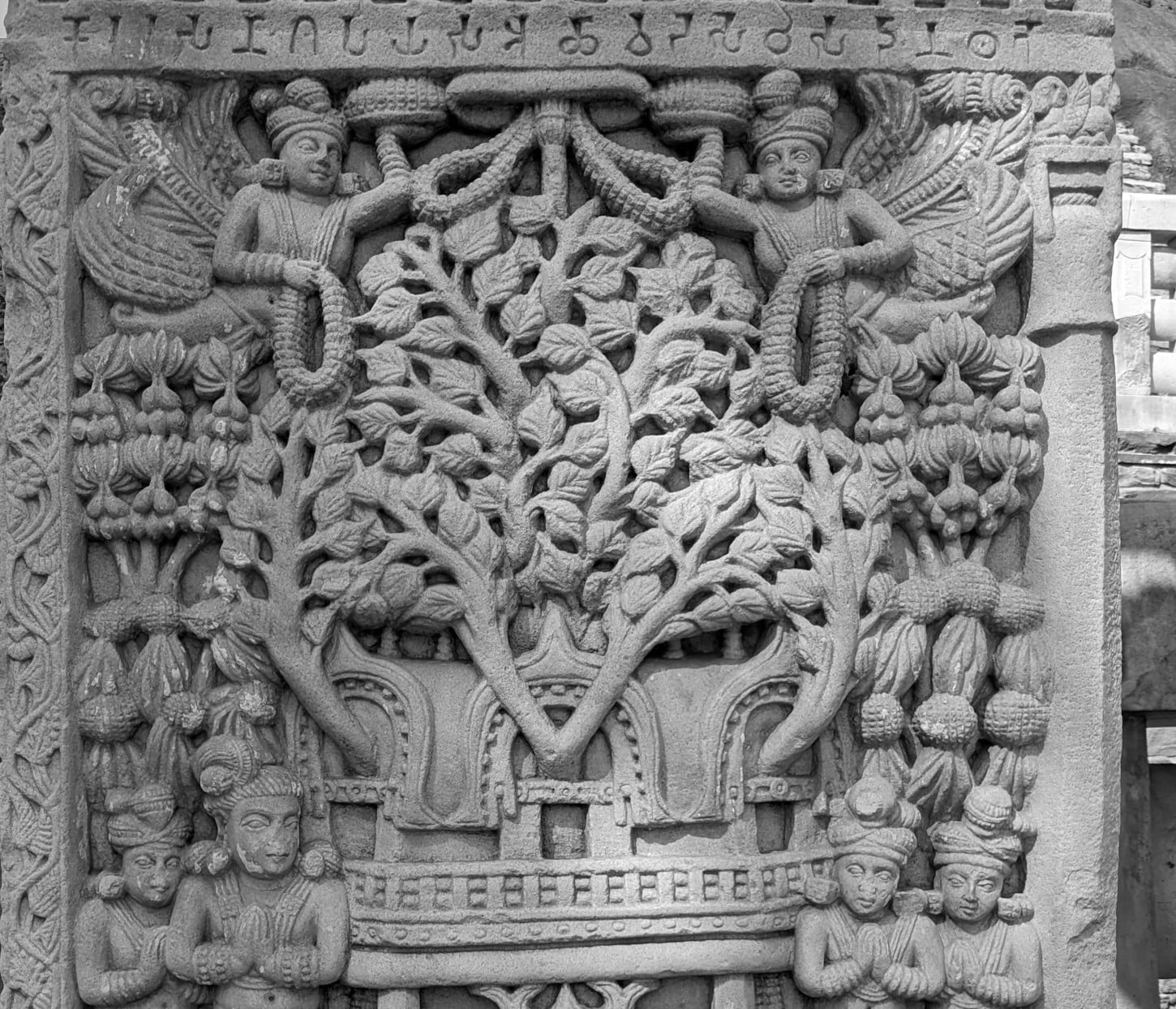
Buddhists consider the tree sacred as Prince Siddhartha sat in meditation under this tree and found enlightenment. The tree since then is known as the Bo or the Bodhi tree. After attaining enlightenment under a Bodhi Tree Lord Buddha is believed to have sat under a Banyan Tree for seven days, absorbed in the extent of his new understanding.
The Great Stupa at Sanchi in Madhya Pradesh, India has many depictions of the bodhi tree which is shown as being worshipped for its association with Lord Buddha. The bodhi tree is an akshaya vata, eternal, life giving tree.
Originally commissioned by King Ashoka in 3rd century B.C many structures were added to the stupa complex by other dynasties. Scenes from Lord Buddha’s life are sculpted on the toranas (gateways) and other structures in and around the stupa.
Legend of the Pardhans
The Pardhans people, a subgroup of the Dravidian, tribal Gond people who live in central India, worship the Banyan tree. here is their legend:
When Guru Jalranda of the Pardhans died, his body was buried by his sons under a tree of Palasa (Butca frondosa). The sons used to light a fire on the grave daily to keep away the wild animals from desecrating the grave.
One day they found a Nyagrodha tree growing out of the grave. The eldest son saw his father in a dream that night who asked him to serve the tree as it had grown out of their father’s bones and brains.
According to the Pardhan’s, the adventitious, hanging roots of the tree are the long and matted hair of the guru.
Sikhism: Parjat – wish-fulfilling Elysian Tree.
In Sikhism, the Sri Guru Granth Sahib’s scriptures have various references to the tree, more commonly referring to it as Parjat, which translates to “Elysian Tree”. From Sanskrit paarijaat (the coral tree Erythrina indica)
ਬਿਰਖੁ ਜਮਿਓ ਹੈ ਪਾਰਜਾਤ॥ ਫੂਲ ਲਗੇ ਫਲ ਰਤਨ ਭਾਂਤਿ॥
Guru Arjan Sahib, Guru Granth Sahib, 1180.
birakh jamio hai paarjaat. phool lage phal ratan bhaaṅt.
A wish-fulfilling tree, which bears flowers and fruits precious like jewels, has sprouted (within my mind).
In the verse above, Guru Arjan Sahib uses this tree as an illustration to help us visualize what can grow in our minds when we make a connection with the Divine.
The paarjat, a night flowering jasmine, is another wish-fulfilling tree mentioned in Hindu mythology.
Next time when you see a Banyan, take a moment off to remember that you are looking at a tree that has been venerated right from the beginning of Indus civilization.

A long journey that is continuing in the form of little shrines that are still extant under roadside ficus trees.
~ ○ ~
Keep exploring:
Works Cited & Multimedia Sources
- Bhagavad Gita. Dakshinamurti.
- https://web.archive.org/web/20230716155628/https://martinifisher.com/2023/06/14/ancient-legends-of-the-sacred-trees/
- https://www.sikh24.com/2016/10/18/gurbani-word-of-the-day-paarjaat/
- https://blessingsonthenet.com/indian-temple/article/478/legend-of-aranya-devi-temple
- https://tourism.bihar.gov.in/en/destinations/bhojpur/aranya-devi-temple
- https://monidipa.net/2018/02/15/kalpavriksha-or-the-tree-of-life-origins-and-historical-relevance/ THANK YOU
- Fergusson James. Tree and Serpent Worship in India. 1869.
- Gupta Shakti M. Plant Myths & Traditions in India. 1968.
- Significance of the Banyan. Times of India. June, 2011.
